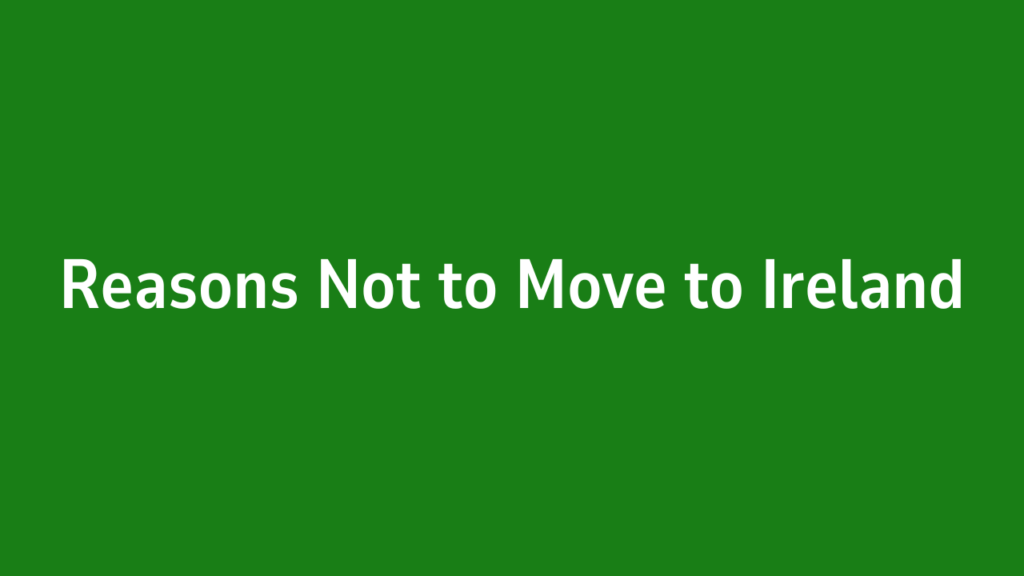Ireland is often praised for its stunning landscapes, vibrant culture, and warm people. But like any country, it isn’t perfect for everyone. Before you decide to pack up your life and move to the Emerald Isle, it’s important to weigh both the pros and cons. In this article, we’ll explore several reasons why Ireland might not be the best choice for you.
1. High Cost of Living
Ireland is one of the most expensive countries in Europe, especially in cities like Dublin, Cork, and Galway.
- Housing: Renting or buying a house is costly. Dublin, in particular, has skyrocketing rents, with even small apartments often exceeding €2,000 per month.
- Utilities: Electricity, water, and heating costs are significantly higher compared to other countries.
- Groceries: Food prices can be steep, especially for imported goods.
| Item | Average Cost in Ireland | Comparison |
|---|---|---|
| Rent (1-bedroom) | €1,800–€2,500/month | Higher than the EU average |
| Electricity (monthly) | €150–€250 | High due to energy taxes |
| Groceries (weekly) | €100–€150 | 30% higher than some EU countries |
2. Unpredictable Weather
Ireland’s weather is notoriously unpredictable.
- Frequent Rain: Rain is a common part of daily life, often falling multiple times a day.
- Grey Skies: The lack of sunshine can affect your mood, especially during winter months.
- Mild But Wet Winters: While it rarely snows, the damp cold can feel uncomfortable.
Weather by Region
| City | Annual Rainfall (mm) | Average Winter Temp (°C) | Average Summer Temp (°C) |
|---|---|---|---|
| Dublin | 731 | 5°C | 19°C |
| Cork | 1,207 | 4°C | 18°C |
| Galway | 1,156 | 5°C | 18°C |
Tip: If you love sunshine and warm weather, Ireland might not be ideal for you.
3. Limited Public Transport Options
While Ireland has public transport, it’s not as comprehensive as in some other European countries.
- Lack of Trains: Many towns and rural areas are not connected by train.
- Infrequent Buses: Buses can be unreliable, especially in smaller towns.
- Car Dependency: Owning a car is often necessary, adding to expenses.
| Mode of Transport | Coverage | Drawback |
|---|---|---|
| Train | Main cities and towns | Limited routes |
| Bus | Cities and rural areas | Delays and irregular schedules |
| Cycling | Cities | Weather makes it less appealing |
4. Long Waiting Times for Healthcare
Ireland’s healthcare system can be a challenge for newcomers.
- Public System Delays: Long waiting lists for treatments and specialist appointments.
- Private Healthcare Costs: Private insurance is expensive but often necessary to avoid delays.
- GP Shortages: Finding a general practitioner (GP) in rural areas can be difficult.
Healthcare Costs Comparison
| Country | Public System Wait Time | Average Private Insurance Cost/Year |
|---|---|---|
| Ireland | Long (6+ months for some) | €1,200–€2,500 |
| UK | Moderate (NHS) | £1,000–£1,500 |
| USA | No public system | $5,000–$10,000 |
Example: It’s not uncommon to wait months for non-urgent medical care.
5. Job Market Challenges
While Ireland has a growing economy, finding a job might not be easy for everyone.
- High Competition: Popular industries like tech and finance are competitive.
- Qualifications Recognition: Some foreign qualifications may not be accepted.
- Rural Job Opportunities: Limited outside of major cities.
Advice: Research job opportunities in your field before moving.
6. High Taxes
Ireland’s tax rates can be a shock for newcomers.
- Income Tax: High for middle and upper-income earners.
- VAT: A standard rate of 23% on most goods and services.
- Property Tax: An added expense for homeowners.
Comparison of Tax Rates
| Country | Income Tax (Top Rate) | VAT |
|---|---|---|
| Ireland | 40% | 23% |
| Germany | 45% | 19% |
| UK | 45% | 20% |
7. Rural Isolation
Ireland’s countryside is beautiful, but it’s not for everyone.
- Limited Amenities: Few shops, schools, or healthcare facilities in remote areas.
- Poor Internet: Slow or unreliable broadband in some rural regions.
- Social Isolation: Harder to build a social circle in sparsely populated areas.
Key Point: If you’re moving for peace and quiet, be prepared for potential loneliness.
8. Cultural Adjustment
While Irish people are known for their friendliness, cultural differences can still be challenging.
- Accent and Dialects: Understanding Irish accents can take time.
- Small-Town Mindset: In rural areas, locals may be curious about newcomers.
- Different Work Culture: A more relaxed approach might differ from what you’re used to.
9. Housing Shortages
Finding suitable accommodation can be difficult.
- Demand vs. Supply: There’s a significant housing shortage, especially in urban areas.
- Old Buildings: Many homes lack modern insulation or central heating.
- Shared Housing: Common among younger professionals due to high costs.
10. Brexit-Related Changes
Brexit has affected Ireland in various ways, including trade and immigration.
- Cost of Goods: Some imported goods from the UK are now more expensive.
- Travel Restrictions: New rules for those from non-EU countries.
- Border Issues: The Northern Ireland border can complicate travel.
11. Limited Entertainment Options
Compared to larger countries, Ireland might feel limited in terms of entertainment.
- Smaller Cities: Less variety in dining, nightlife, and cultural events.
- Remote Locations: Fewer entertainment options in rural areas.
- Seasonal Activities: Some attractions are only open during the summer months.
Conclusion
Moving to Ireland can be a dream for many, but it’s not without its challenges. From the high cost of living to unpredictable weather and limited public transport, there are several factors to consider before making the leap. While Ireland offers a rich culture and beautiful scenery, it’s essential to weigh these against potential drawbacks to determine if it’s the right place for you.
By understanding these challenges, you can make an informed decision and prepare for life on the Emerald Isle—if you choose to go.
FAQs About Living in Ireland
Is it hard to adjust to life in Ireland?
For some, yes. The weather, cost of living, and cultural differences might take time to adapt to.
What are the main reasons people leave Ireland?
High costs, healthcare issues, and limited opportunities in rural areas are common reasons.
How much money do you need to live comfortably in Ireland?
A single person in Dublin needs about €3,000 per month, while a family might require €5,000 or more.

Hi, I’m Tanvir, the founder and author of Explore Ireland Now. With a deep love for Ireland and its rich culture, history, and landscapes, I created this site to share everything that makes this beautiful country worth exploring. Whether you’re a local looking for hidden gems or a traveler planning your next adventure, I provide insightful guides, tips, and recommendations to help you experience Ireland to the fullest.
From stunning landscapes to vibrant cities and quaint villages, Ireland is full of wonders waiting to be discovered. Through my personal experiences and research, I aim to bring you the most up-to-date information and inspiration for your journey.
Thank you for visiting Explore Ireland Now—I hope my content helps you uncover all that this incredible country has to offer! If you have any questions or need travel advice, feel free to reach out.



